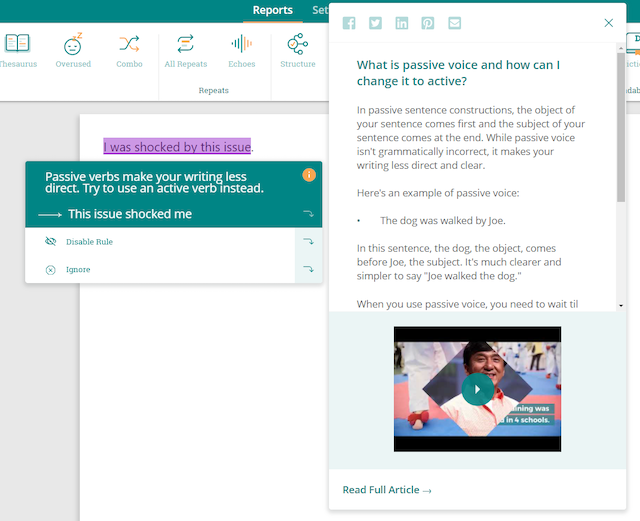
Customer service certainly isn’t an easy job. As a department, it’s rarely given the revenue generating credit it’s due. And as an industry, it’s plagued by agent burnout and a turnover rate three times higher than the average across all industries.
Employee engagement is often cited as the cure to these problems, but that’s easier said than done.
So why is it so hard to engage CS teams?
First, there’s the nature of the work. Customer service is a emotionally demanding industry. While it can be worth the reward to make customers happy, dealing with unhappy or angry customers is never easy.
Then, there’s the scoring. CS is often based on QA, NPS or CSAT scores. These metrics are often tied back to ticket resolution speed.
So we’re taking an emotionally demanding industry and adding time pressure to it. No wonder team engagement is hard!
And then on top of all that, there’s the writing.
Writing is Hard, Training Good Writers is Harder
Take a look at any list of support channels and you’ll find at least 50% require writing, including:
- Live chat
- Social media channels
Forums
And that's just for customer-facing agents. Someone on your team will probably also be writing self-serve resources like chat bot responses and knowledge bases.
As we all know, writing is hard. Most of us talk about it like a talent you either have or you don’t.
It's easy to understand why. We know good writing when we see it, but it’s hard to describe exactly what’s wrong with bad writing.
So where does this leave your team of representatives? Do you hire only fantastic writers, regardless of the other skills they have? Or do you take massive chunks of time out of their schedule to train? Or do you rely on peer review, doubling up the workload for your best writers?
And after training, how do you monitor how agents are doing? How do you tell them what they need to improve? What they did right?
The answer? You need a plan and the right tools.
A Training Plan for Writing in Customer Service
Training better customer service writers relies on three points:
- Accessible learning resources
- Rapid feedback
Objective scoring Let’s look at each.

The Right Training
Training your team often conjures images of days long workshops or recurring meetings. And to your C-suite and directors, that translates to high costs and lost productivity.
It’s true that certain automation tools can cut down on the need for training. Text expanders can save commonly used scripts so your team doesn’t have to constantly rework the same responses and explanations. And company style guides can be used as training material if you develop them effectively.
But, better writing is a process of continuous development. Even the most lauded writers on earth have coaches.
For teams with smaller budgets, you may not be able to take the time out for training sessions. Fortunately, with ProWritingAid, your team can learn on the fly.
Unlike tools like Grammarly, ProWritingAid is built with learning at its foundation. Instead of long workshops, your team can learn in the flow of work.
The resources in our in-app learning tools can help your team understand exactly why certain grammar mistakes are an issue. Plus, our blog and webinars are dedicated to helping all kinds of writers improve their skills.
With all the resources in they need in one place, your CS agents can build their training seamlessly into their daily workflow.
Rapid Feedback
The next step to great writing is feedback. In customer service teams, this feedback usually comes in the form of peer review or QA scores. These are great to help ward off future issues, but can’t help correct mistakes before they happen.
ProWritingAid’s Realtime checker can.
The real time checker is like giving each of your representatives their own editor. At any time, they can get feedback on what they’re writing. Our range of integrations mean your team can write anywhere and get corrections whenever they need them.
And if your team has a style guide or other team rules to follow, you can automate your guide with our style guide tool. Your brand name will never be mis-capitalized or misspelled again.

Scoring Writing as a Science
Everyone tends to treat writing as an art form. You either have the talent or you don’t. But, in business, writing is a skill. One that anyone can improve.
Most customer service teams try to improve writing through peer reviews or performance reviews involving QA scores. Unfortunately, both of those methods are highly subjective.
Because they’re driven by human opinion, they’re not consistent. What one rep might rate as a 7 in peer review, another might rate as a 5. And the depth of the feedback will vary highly depending on the writing skill of each person involved.
Plus, the reviews are time consuming, delaying the feedback process. And for native English speakers, it’s often hard to explain the “why” behind certain rules to non-native speakers beyond “it sounds wrong.”
At ProWritingAid, we’ve analyzed hundreds of thousands of papers to figure out what makes good writing work. And we’ve transformed that analysis into a tool for our users. Meet Goals.
Our goals sidebar breaks down target ranges for every aspect of your writing. It can be fine-tuned by the type of writing you’re doing and the category of document you’re working on.
Goals give your team an active benchmark to aim for. It’s an objective score they have instant access to, no extra legwork required.
And that can give you peace of mind that every communication meets your standards. It also frees up your peer review sessions to dive into deeper issues rather than discussing where to put commas or how to correct a run-on sentence.
The ROI of Good Writing in Customer Service
It’s no secret that customer service doesn’t get it’s due when it comes to revenue generation.
Though customer service is often the number one touch point for current customers, it’s rarely given credit for the impact it has on branding. And execs typically see it as a cost center rather than the revenue generator it truly is.
Unfortunately, customer service may also have the toughest job in the company: keeping customers happy. And in today’s post-COVID world, customer expectations are higher than ever.
Less than 4% of customers will stick with a company after a bad customer service experience. And 52% of customers feel that customer service has either not changed or gotten worse since 2019.
Since so many support channels are text-based, your team will often be judged by the quality of their writing. If a customer is bogged down by a long-winded or confusing explanation, the unpleasant experience may lose your company business.
Good writing, on the other hand, makes for an excellent customer experience. When your team writes with their readers in mind, your customers will know it. Explanations are clearer and easier to understand and tickets can be resolved with less back and forth. Satisfied customers make loyal customers.
But what’s the initial investment for the kind of training required to make great writers?
The average traditional training program costs $300 per person for a single-day course and $500-$1000 per person for a full continuing education course. That’s just the upfront cost—not adding in lost time on tickets.
But ProWritingAid’s teams plan costs $8.00 per user seat per month. For a team of seven, that’s less than $700 a year. Meaning you get twelve months of continuous writing improvements for less than a quarter of the cost of the least expensive traditional writing program. Plus, there’s no time lost to extra training.
If you’re looking for more on how to convince your directors that customer service is a profit center, check out our webinar with GQ Fu of LTVplus:
We'll cover how software like ProWritingAid can boost your team's speed and quality, no matter how many tickets they have to go through. Then, we'll discuss the right way to design macros and scripts so your team can personalize every customer interaction. And finally, GQ will share the same frameworks he uses at LTVplus to transform outsourced agents into the mouthpiece of a brand in the least amount of time.

